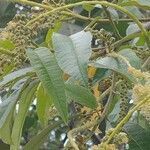Shrubs or climbers, 2--10 m; branchlets, leaf blades abaxially, petioles, and inflorescences densely grayish white stellate tomentose, drying rusty. Branchlets terete. Petiole 0.5--2 cm; leaf blade narrowly ovate to elliptic, 2--14 X 1.5--7 cm, adaxially glabrous or subglabrous, base rounded, acute, cuneate, or rarely subcordate, margin entire, apex acuminate, lateral veins 6--12 pairs. Inflorescences terminal, paniculate or thyrsoid, 5--25 X 2--15 cm. Calyx campanulate to urceolate, 2--3.5 cm; lobes broadly triangular, 0.4--1 X 0.5--1 mm. Corolla dark yellow, orange, or salmon; tube 7--10 mm, outside stellate tomentose, inside with a pilose belt; lobes ovate to suborbicular, 2--4 X 2--3 mm. Stamens inserted just below corolla mouth; anthers oblong, 1--1.4 mm. Ovary subglobose, 1--1.5 mm, apex stellate tomentose, 4-locular. Style base stellate tomentose; stigma clavate, 1.2--1.7 mm. Berries white at first, purple-blue when ripe, globose, 2.5--5 mm in diam., glandular pubescent or glabrous, often stellate tomentose at apex. Seeds ellipsoid to obliquely ovoid, ca. 1 X 0.5 mm, unwinged. Fl. Apr-Jun, fr. Aug-Nov. 2n = 38.
Large spreading or rambling evergreen shrub to c. 5 m high. Shoots obscurely angular, tomentose. Lvs opposite; petioles 1-2.5 cm long; lamina 6-14 × 1.7-5.5 cm, lanceolate-ovate or lanceolate-elliptic, soon becoming glabrous above, white or pale brownish tomentose beneath, entire or slightly crenulate on vegetative shoots; base rounded, less often broad-cuneate or subcordate; apex acute. Panicles to c. 25 cm long, cylindric, rather tomentose; fls fragrant, sessile or subsessile, sometimes loose in the raceme. Bracts linear-subulate, to c. 6 mm long. Calyx 2.5-4 mm long; lobes short and triangular. Corolla tomentose outside; tube 6-7 mm long, pale yellow; lobes 2-3 mm long, pale yellow, becoming orange. Stamens inserted near apex of corolla tube, included; anthers sessile. Style slightly < stamens. Ovary tomentose at apex. Fr. not seen.
A shrub. It can be climbing. It grows 4 m tall. The leaves are opposite and narrowly oval. They are 12 cm long on leaf stalks 20 cm long. The flowers are in long slender groups up to 25 cm long. They have a scent. They can be yellow, orange or pink.


